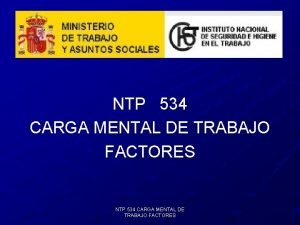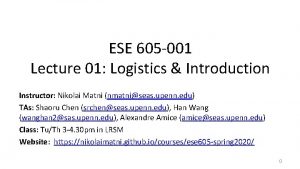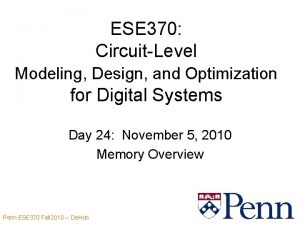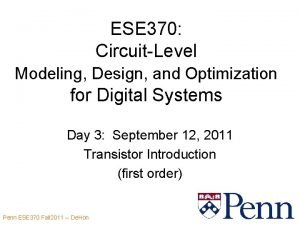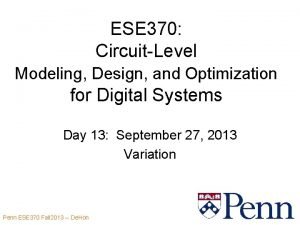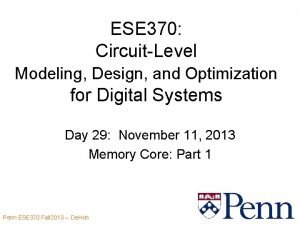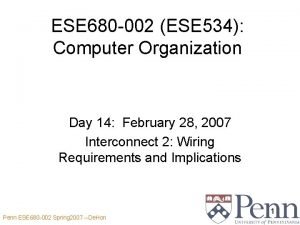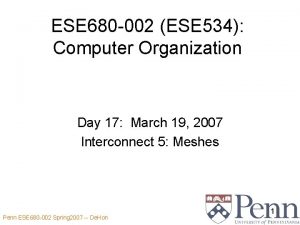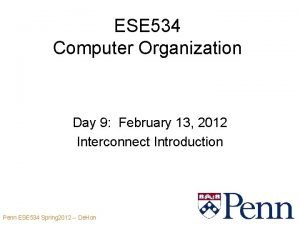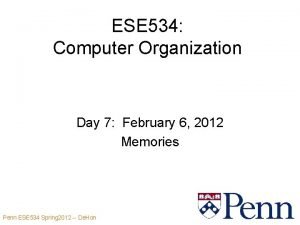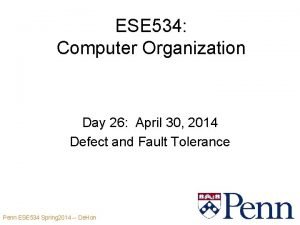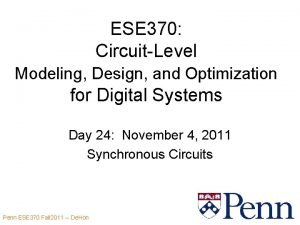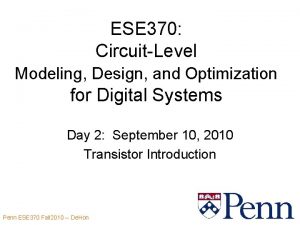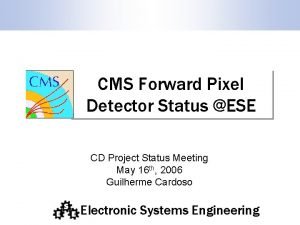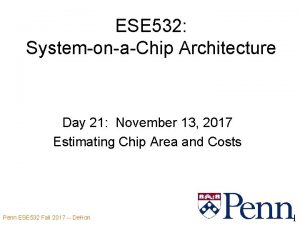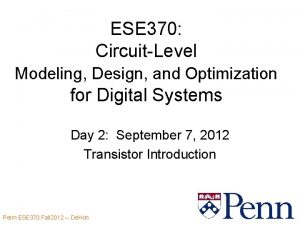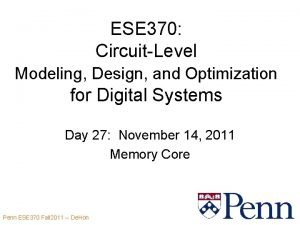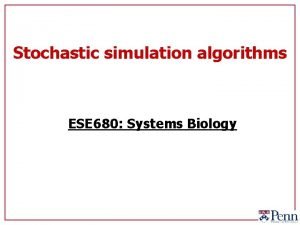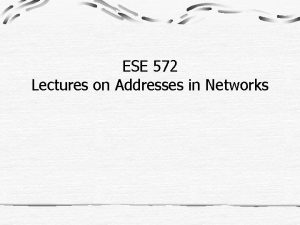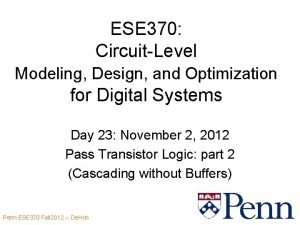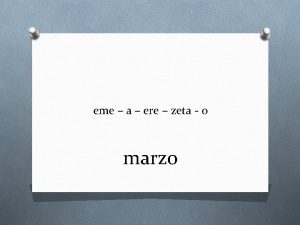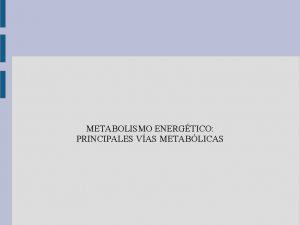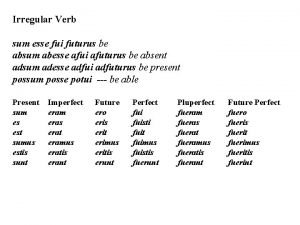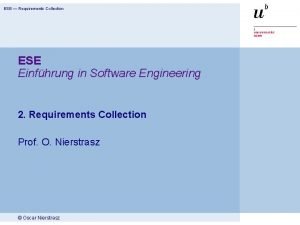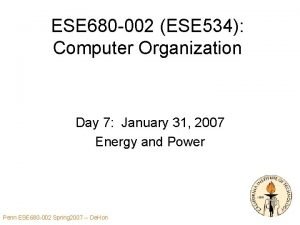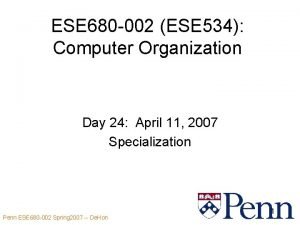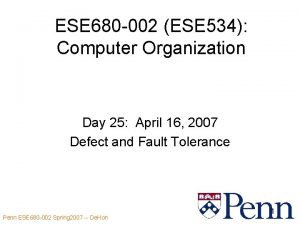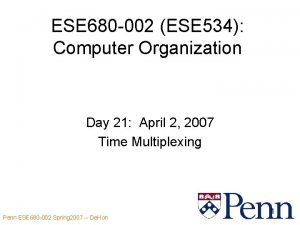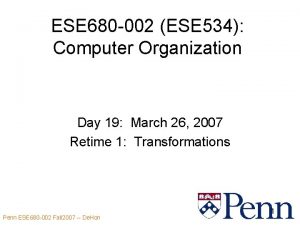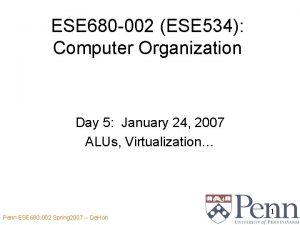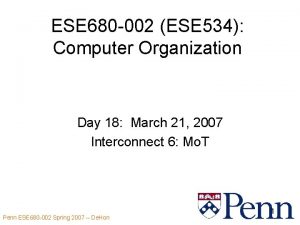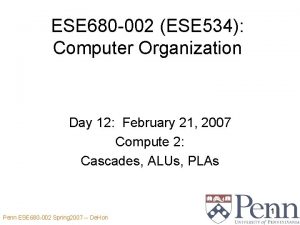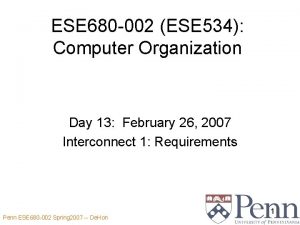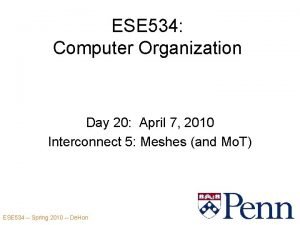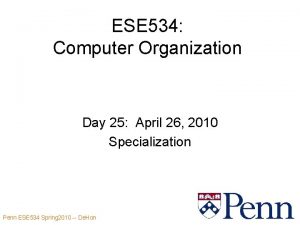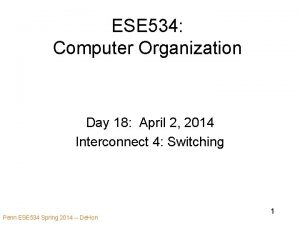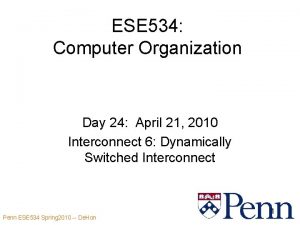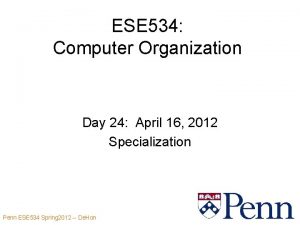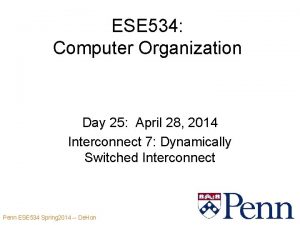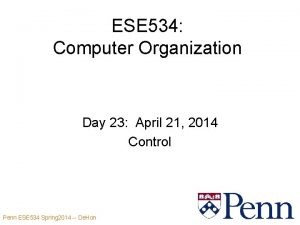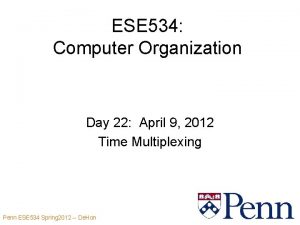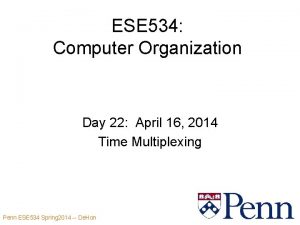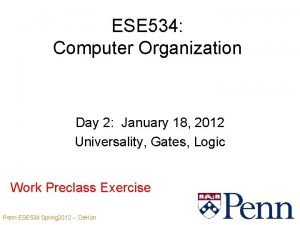ESE 534 Computer Organization Day 26 April 30














































![In Practice • Crossbars are inefficient [Day 1619] • Use switching networks with – In Practice • Crossbars are inefficient [Day 1619] • Use switching networks with –](https://slidetodoc.com/presentation_image_h/d661861fc502a7338fd56f199ad1de43/image-47.jpg)







































- Slides: 86

ESE 534: Computer Organization Day 26: April 30, 2014 Defect and Fault Tolerance Penn ESE 534 Spring 2014 -- De. Hon 1

Today • Defect and Fault Tolerance – Problem – Defect Tolerance – Fault Tolerance Penn ESE 534 Spring 2014 -- De. Hon 2

Warmup Discussion • Where do we guard against defects and faults today? – Where do we accept imperfection today? Penn ESE 534 Spring 2014 -- De. Hon 3

Motivation: Probabilities • Given: – N objects – Pg yield probability • What’s the probability for yield of composite system of N items? [Preclass 1] – Assume iid faults – P(N items good) = (Pg)N Penn ESE 534 Spring 2014 -- De. Hon 4

Probabilities • Pall_good(N)= (Pg)N • P=0. 999999 N 104 105 106 107 Penn ESE 534 Spring 2014 -- De. Hon Pall_good(N) 5

Probabilities • Pall_good(N)= (Pg)N • P=0. 999999 N 104 105 106 107 Penn ESE 534 Spring 2014 -- De. Hon Pall_good(N) 0. 99 0. 90 0. 37 0. 000045 6

Simple Implications • As N gets large – must either increase reliability – …or start tolerating failures • N – – – – memory bits disk sectors wires transmitted data bits processors transistors molecules Penn ESE 534 Spring 2014 -- De. Hon – As devices get smaller, failure rates increase – chemists think P=0. 95 is good – As devices get faster, failure rate 7 increases

Failure Rate Increases Penn ESE 534 Spring 2014 -- De. Hon [Nassif / DATE 2010] 8

Quality Required for Perfection? • How high must Pg be to achieve 90% yield on a collection of 1010 devices? [preclass 3] Pg>1 -10 -11 Penn ESE 534 Spring 2014 -- De. Hon 9

Failure Rate Increases Penn ESE 534 Spring 2014 -- De. Hon [Nassif / DATE 2010] 10

Defining Problems Penn ESE 534 Spring 2014 -- De. Hon 11

Three Problems 1. Defects: Manufacturing imperfection – Occur before operation; persistent • Shorts, breaks, bad contact 2. Transient Faults: – Occur during operation; transient • node X value flips: crosstalk, ionizing particles, bad timing, tunneling, thermal noise 3. Lifetime “wear” defects – Parts become bad during operational lifetime • Fatigue, electromigration, burnout…. – …slower • NBTI, Hot Carrier Injection Penn ESE 534 Spring 2014 -- De. Hon 12

Sherkhar Bokar Intel Fellow Micro 37 (Dec. 2004) Penn ESE 534 Spring 2014 -- De. Hon 13

Defect Rate • • Device with 1011 elements (100 BT) 3 year lifetime = 108 seconds Accumulating up to 10% defects 1010 defects in 108 seconds 1 new defect every 10 ms • At 10 GHz operation: • One new defect every 108 cycles • Pnewdefect=10 -19 Penn ESE 534 Spring 2014 -- De. Hon 14

First Step to Recover Admit you have a problem (observe that there is a failure) Penn ESE 534 Spring 2014 -- De. Hon 15

Detection • How do we determine if something wrong? – Some things easy • …. won’t start – Others tricky • …one and gate computes False & True • Observability – can see effect of problem – some way of telling if defect/fault present Penn ESE 534 Spring 2014 -- De. Hon 16

Detection • Coding – space of legal values << space of all values – should only see legal – e. g. parity, ECC (Error Correcting Codes) • Explicit test (defects, recurring faults) – ATPG = Automatic Test Pattern Generation – Signature/BIST=Built-In Self-Test – POST = Power On Self-Test • Direct/special access – test ports, scan paths Penn ESE 534 Spring 2014 -- De. Hon 17

Coping with defects/faults? • Key idea: redundancy • Detection: – Use redundancy to detect error • Mitigating: use redundant hardware – Use spare elements in place of faulty elements (defects) – Compute multiple times so can discard faulty result (faults) Penn ESE 534 Spring 2014 -- De. Hon 18

Defect Tolerance Penn ESE 534 Spring 2014 -- De. Hon 19

Two Models • Disk Drives (defect map) • Memory Chips (perfect chip) Penn ESE 534 Spring 2014 -- De. Hon 20

Disk Drives • Expose defects to software – software model expects faults • Create table of good (bad) sectors – manages by masking out in software • (at the OS level) • Never allocate a bad sector to a task or file – yielded capacity varies Penn ESE 534 Spring 2014 -- De. Hon 21

Memory Chips • Provide model in hardware of perfect chip • Model of perfect memory at capacity X • Use redundancy in hardware to provide perfect model • Yielded capacity fixed – discard part if not achieve Penn ESE 534 Spring 2014 -- De. Hon 22

Example: Memory • Correct memory: – N slots – each slot reliably stores last value written • Millions, billions, etc. of bits… – have to get them all right? Penn ESE 534 Spring 2014 -- De. Hon 23

Failure Rate Increases Penn ESE 534 Spring 2014 -- De. Hon [Nassif / DATE 2010] 24

Memory Defect Tolerance • Idea: – few bits may fail – provide more raw bits – configure so yield what looks like a perfect memory of specified size Penn ESE 534 Spring 2014 -- De. Hon 25

Memory Techniques • Row Redundancy • Column Redundancy • Bank Redundancy Penn ESE 534 Spring 2014 -- De. Hon 26

Row Redundancy • Provide extra rows • Mask faults by avoiding bad rows • Trick: – have address decoder substitute spare rows in for faulty rows – use fuses to program Penn ESE 534 Spring 2014 -- De. Hon 27

Spare Row Penn ESE 534 Spring 2014 -- De. Hon 28

Column Redundancy • Provide extra columns • Program decoder/mux to use subset of columns Penn ESE 534 Spring 2014 -- De. Hon 29

Spare Memory Column • Provide extra columns • Program output mux to avoid Penn ESE 534 Spring 2014 -- De. Hon 30

Bank Redundancy • Substitute out entire bank – e. g. memory subarray • include 5 banks – only need 4 to yield perfect • (N+1 sparing more typical for larger N) Penn ESE 534 Spring 2014 -- De. Hon 31

Spare Bank Penn ESE 534 Spring 2014 -- De. Hon 32

Yield M of N • Preclass 4: Probability of yielding 3 of 5 things? – Symbolic? – Numerical for Pg=0. 9? Penn ESE 534 Spring 2014 -- De. Hon 33

Yield M of N • P(M of N) = P(yield N) + (N choose N-1) P(exactly N-1) + (N choose N-2) P(exactly N-2)… + (N choose N-M) P(exactly N-M)… [think binomial coefficients] Penn ESE 534 Spring 2014 -- De. Hon 34

M of 5 example • 1*P 5 + 5*P 4(1 -P)1+10 P 3(1 -P)2+10 P 2(1 P)3+5 P 1(1 -P)4 + 1*(1 -P)5 • Consider P=0. 9 – – – 1*P 5 5*P 4(1 -P)1 10 P 3(1 -P)2 10 P 2(1 -P)3 5 P 1(1 -P)4 1*(1 -P)5 Penn ESE 534 Spring 2014 -- De. Hon 0. 59 0. 33 0. 07 0. 008 0. 00045 0. 00001 M=5 P(sys)=0. 59 M=4 P(sys)=0. 92 M=3 P(sys)=0. 99 Can achieve higher system yield than 35 individual components!

Repairable Area • Not all area in a RAM is repairable – memory bits spare-able – io, power, ground, control not redundant Penn ESE 534 Spring 2014 -- De. Hon 36

Repairable Area • P(yield) = P(non-repair) * P(repair) • P(non-repair) = PNnr – Nnr<<Ntotal – P > Prepair • e. g. use coarser feature size • Differential reliability • P(repair) ~ P(yield M of N) Penn ESE 534 Spring 2014 -- De. Hon 37

Consider a Crossbar • Allows us to connect any of N things to each other – E. g. • N processors • N memories • N/2 processors + N/2 memories Penn ESE 534 Spring 2014 -- De. Hon 38

Crossbar Buses and Defects • Two crossbars • Wires may fail • Switches may fail • Provide more wires – Any wire fault avoidable • M choose N Penn ESE 534 Spring 2014 -- De. Hon 39

Crossbar Buses and Defects • Two crossbars • Wires may fail • Switches may fail • Provide more wires – Any wire fault avoidable • M choose N Penn ESE 534 Spring 2014 -- De. Hon 40

Crossbar Buses and Faults • Two crossbars • Wires may fail • Switches may fail • Provide more wires – Any wire fault avoidable • M choose N Penn ESE 534 Spring 2014 -- De. Hon 41

Crossbar Buses and Faults • Two crossbars • Wires may fail • Switches may fail • Provide more wires – Any wire fault avoidable • M choose N – Same idea Penn ESE 534 Spring 2014 -- De. Hon 42

Simple System • P Processors • M Memories • Wires Memory, Compute, Interconnect Penn ESE 534 Spring 2014 -- De. Hon 43

Simple System w/ Spares • • P Processors M Memories Wires Provide spare – Processors – Memories – Wires Penn ESE 534 Spring 2014 -- De. Hon 44

Simple System w/ Defects • • P Processors M Memories Wires Provide spare – Processors – Memories – Wires • . . . and defects Penn ESE 534 Spring 2014 -- De. Hon 45

Simple System Repaired • • P Processors M Memories Wires Provide spare – Processors – Memories – Wires • Use crossbar to switch together good processors and memories Penn ESE 534 Spring 2014 -- De. Hon 46
![In Practice Crossbars are inefficient Day 1619 Use switching networks with In Practice • Crossbars are inefficient [Day 1619] • Use switching networks with –](https://slidetodoc.com/presentation_image_h/d661861fc502a7338fd56f199ad1de43/image-47.jpg)
In Practice • Crossbars are inefficient [Day 1619] • Use switching networks with – Locality – Segmentation • …but basic idea for sparing is the same Penn ESE 534 Spring 2014 -- De. Hon 47

Defect Tolerance Questions? Penn ESE 534 Spring 2014 -- De. Hon 48

Fault Tolerance Penn ESE 534 Spring 2014 -- De. Hon 49

Faults • Bits, processors, wires – May fail during operation • Basic Idea same: – Detect failure using redundancy – Correct • Now – Must identify and correct online with the computation Penn ESE 534 Spring 2014 -- De. Hon 50

Transient Sources • Effects – Thermal noise – Timing – Ionizing particles • a particle 105 to 106 electrons • Calculated gates with 15 --30 electrons Day 6 – Even if CMOS restores, takes time Penn ESE 534 Spring 2014 -- De. Hon 51

Voltage and Error Rate Penn ESE 534 Spring 2014 -- De. Hon 52 [Austin et al. --IEEE Computer, March 2004]

–SEU/bit Norm to 130 nm Scaling and Error Rates –Increasing Error Rates – 10 – 2 X bit/latch count increase per generation –logic –cache –arrays – 180 – 130 – 90 – 65 – 45 – 32 –Technology (nm) Penn ESE 534 Spring 2014 -- De. Hon Source: Carter/Intel 53 53

Errors versus Frequency –VCC & Temperature –FCLK Guardband –Resilient Design Max TP –Conventional Design –Max TP Penn ESE 534 Spring 2014 -- De. Hon [Bowman, ISSCC 2008] 54

Simple Memory Example • Problem: bits may lose/change value – Alpha particle – Molecule spontaneously switches • Idea: – Store multiple copies – Perform majority vote on result Penn ESE 534 Spring 2014 -- De. Hon 55

Redundant Memory Penn ESE 534 Spring 2014 -- De. Hon 56

Redundant Memory • • Like M-choose-N Only fail if >(N-1)/2 faults P=0. 9 P(2 of 3) All good: (0. 9)3 = 0. 729 + Any 2 good: 3(0. 9)2(0. 1)=0. 243 = 0. 971 Penn ESE 534 Spring 2014 -- De. Hon 57

Better: Less Overhead • Don’t have to keep N copies • Block data into groups • Add a small number of bits to detect/correct errors Penn ESE 534 Spring 2014 -- De. Hon 58

Row/Column Parity • Think of Nx. N bit block as array • Compute row and column parities – (total of 2 N bits) Penn ESE 534 Spring 2014 -- De. Hon 59

Row/Column Parity • Think of Nx. N bit block as array • Compute row and column parities – (total of 2 N bits) • Any single bit error Penn ESE 534 Spring 2014 -- De. Hon 60

Row/Column Parity • Think of Nx. N bit block as array • Compute row and column parities – (total of 2 N bits) • Any single bit error • By recomputing parity – Know which one it is – Can correct it Penn ESE 534 Spring 2014 -- De. Hon 61

In. Class Exercise • Which Block has an error? • What correction do we need? Penn ESE 534 Spring 2014 -- De. Hon 62

Row/Column Parity • Simple case is 50% overhead – Add 8 bits to 16 – Better than 200% with 3 copies – More expensive than used in practice Penn ESE 534 Spring 2014 -- De. Hon 63

In Use Today • Conventional DRAM Memory systems – Use 72 b ECC (Error Correcting Code) – On 64 b words [12. 5% overhead] – Correct any single bit error – Detect multibit errors • CD and flash blocks are ECC coded – Correct errors in storage/reading Penn ESE 534 Spring 2014 -- De. Hon 64

RAID • Redundant Array of Inexpensive Disks • Disk drives have ECC on sectors – At least enough to detect failure • RAID-5 has one parity disk – Tolerate any single disk failure – E. g. 8 -of-9 survivability case – With hot spare, can rebuild data on spare Penn ESE 534 Spring 2014 -- De. Hon 65

Interconnect • Also uses checksums/ECC – Guard against data transmission errors – Environmental noise, crosstalk, trouble sampling data at high rates… • Often just detect error • Recover by requesting retransmission – E. g. TCP/IP (Internet Protocols) Penn ESE 534 Spring 2014 -- De. Hon 66

Interconnect • • Also guards against whole path failure Sender expects acknowledgement If no acknowledgement will retransmit If have multiple paths – …and select well among them – Can route around any fault in interconnect Penn ESE 534 Spring 2014 -- De. Hon 67

Interconnect Fault Example • Send message • Expect Acknowledgement Penn ESE 534 Spring 2014 -- De. Hon 68

Interconnect Fault Example • Send message • Expect Acknowledgement • If Fail Penn ESE 534 Spring 2014 -- De. Hon 69

Interconnect Fault Example • Send message • Expect Acknowledgement • If Fail – No ack Penn ESE 534 Spring 2014 -- De. Hon 70

Interconnect Fault Example • If Fail no ack – Retry – Preferably with different resource Penn ESE 534 Spring 2014 -- De. Hon 71

Interconnect Fault Example • If Fail no ack – Retry – Preferably with different resource Ack signals success Penn ESE 534 Spring 2014 -- De. Hon 72

Compute Elements • Simplest thing we can do: – Compute redundantly – Vote on answer – Similar to redundant memory Penn ESE 534 Spring 2014 -- De. Hon 73

Compute Elements • Unlike Memory – State of computation important – Once a processor makes an error • All subsequent results may be wrong • Response – “reset” processors which fail vote – Go to spare set to replace failing processor Penn ESE 534 Spring 2014 -- De. Hon 74

In Use • NASA Space Shuttle – Uses set of 4 voting processors • Boeing 777 – Uses voting processors • Uses different architectures for processors • Uses different software • Avoid Common-Mode failures – Design errors in hardware, software Penn ESE 534 Spring 2014 -- De. Hon 75

Forward Recovery • Can take this voting idea to gate level – Von. Neuman 1956 • Basic gate is a majority gate – Example 3 -input voter • Alternate stages – Compute – Voting (restoration) • Number of technical details… • High level bit: – Requires Pgate>0. 996 – Can make whole system as reliable as individual gate Penn ESE 534 Spring 2014 -- De. Hon 76

Majority Multiplexing Maybe there’s a better way… Penn ESE 534 Spring 2014 -- De. Hon [Roy+Beiu/IEEE Nano 2004] 77

Detect vs. Correct • Detection is cheaper than correction • To handle k-faults – Voting correction requires 2 k+1 • K=1 3 – Detection requires k+1 • K=1 2 Penn ESE 534 Spring 2014 -- De. Hon 78

Rollback Recovery • Commit state of computation at key points – to memory (ECC, RAID protected. . . ) – …reduce to previously solved problem of protecting memory • On faults (lifetime defects) – recover state from last checkpoint – like going to last backup…. – …(snapshot) Penn ESE 534 Spring 2014 -- De. Hon 79

Rollback vs. Forward Penn ESE 534 Spring 2014 -- De. Hon 80

Defect vs. Fault Tolerance • Defect – Can tolerate large defect rates (10%) • Use virtually all good components • Small overhead beyond faulty components • Fault – Require lower fault rate (e. g. VN <0. 4%) • Overhead to do so can be quite large Penn ESE 534 Spring 2014 -- De. Hon 81

Fault/Defect Models • i. i. d. fault (defect) occurrences easy to analyze • Good for? • Bad for? • Other models? – Spatially or temporally clustered – Burst – Adversarial Penn ESE 534 Spring 2014 -- De. Hon 82

Summary • Possible to engineer practical, reliable systems from – Imperfect fabrication processes (defects) – Unreliable elements (faults) • We do it today for large scale systems – Memories (DRAMs, Hard Disks, CDs) – Internet • …and critical systems – Space ships, Airplanes • Engineering Questions – Where invest area/effort? • Higher yielding components? Tolerating faulty components? Penn ESE 534 Spring 2014 -- De. Hon 83

Big Ideas • Left to itself: – reliability of system << reliability of parts • Can design – system reliability >> reliability of parts [defects] – system reliability ~= reliability of parts [faults] • For large systems – must engineer reliability of system – …all systems becoming “large” Penn ESE 534 Spring 2014 -- De. Hon 84

Big Ideas • Detect failures – static: directed test – dynamic: use redundancy to guard • Repair with Redundancy • Model – establish and provide model of correctness • Perfect component model (memory model) • Defect map model (disk drive model) Penn ESE 534 Spring 2014 -- De. Hon 85

Admin • Discussion period ends today – From midnight on, no discussion of approaches to final • FM 2 due today – Get them in today and feedback by weekend • Final due Monday, May 12 (10 pm) – No late finals • André traveling next two weeks Penn ESE 534 Spring 2014 -- De. Hon 86
 Day 1 day 2 day 3 day 4
Day 1 day 2 day 3 day 4 Ntp 534
Ntp 534 Day 1 day 2 day 817
Day 1 day 2 day 817 Process organization in computer organization
Process organization in computer organization Basic structure of computer in computer organization
Basic structure of computer in computer organization Organization and architecture difference
Organization and architecture difference Design of basic computer with flowchart
Design of basic computer with flowchart Design of basic computer in computer architecture
Design of basic computer in computer architecture Astronomy picture of the day 17 april 2001
Astronomy picture of the day 17 april 2001 Poems by kenn nesbitt
Poems by kenn nesbitt 20/4/1889
20/4/1889 This day in history april 15
This day in history april 15 National sovereignty and childrens day
National sovereignty and childrens day History of april fools day in islam
History of april fools day in islam International day april 4
International day april 4 April 28 day of mourning
April 28 day of mourning Point by point organization example
Point by point organization example Family sis schoolmax
Family sis schoolmax Haiku and
Haiku and Day to day maintenance
Day to day maintenance Physical science chapter 6 review answers
Physical science chapter 6 review answers I don't know tomorrow
I don't know tomorrow Romeo and juliet timeline act 2
Romeo and juliet timeline act 2 Growing day by day
Growing day by day Define seed dormancy
Define seed dormancy Germination conclusion
Germination conclusion Seeds vs spores
Seeds vs spores I live for jesus day after day
I live for jesus day after day One day casting crowns
One day casting crowns Day one day one noodle ss2
Day one day one noodle ss2 Day one day one ss2
Day one day one ss2 Ese argumentuese bindese
Ese argumentuese bindese Sjellja konsumatore pdf
Sjellja konsumatore pdf Jeta private ese
Jeta private ese Uilliam shekspir
Uilliam shekspir Lufta e dyte boterore projekt
Lufta e dyte boterore projekt Ferri jane te tjeret ese
Ferri jane te tjeret ese Korn ese viejo nuevo metal
Korn ese viejo nuevo metal Ese 605 upenn
Ese 605 upenn Ese 532
Ese 532 Ese 532
Ese 532 Ese 532
Ese 532 Ese 532
Ese 532 Ese 370
Ese 370 Ese 370
Ese 370 Ese 370
Ese 370 Ese 370
Ese 370 Ese es mi gallo significado denotativo
Ese es mi gallo significado denotativo Roli i drejtuesit te grupit
Roli i drejtuesit te grupit Exchange rate definition
Exchange rate definition Ese
Ese How to make a project
How to make a project Ese
Ese Ese
Ese Ese
Ese Ese
Ese Nasa space shuttle
Nasa space shuttle Ese 532
Ese 532 Ese 370
Ese 370 Ese 370
Ese 370 Este, ese, aquel
Este, ese, aquel Ese status
Ese status Ese exchange
Ese exchange Ese 532
Ese 532 Ese 532
Ese 532 Ese 532
Ese 532 Vds vgs
Vds vgs Ese 370
Ese 370 Ese 22
Ese 22 Recuerdas aquel dia pues desde ese dia
Recuerdas aquel dia pues desde ese dia La verdad yo no comparto ese desprecio a los nuevos ricos
La verdad yo no comparto ese desprecio a los nuevos ricos Ese 680
Ese 680 ¿te has sentido sanado por dios?
¿te has sentido sanado por dios? En ese momento preterite or imperfect
En ese momento preterite or imperfect Qué ha sido escrito este texto
Qué ha sido escrito este texto Este hombre del casino provinciano
Este hombre del casino provinciano Ese 680
Ese 680 Ese 572
Ese 572 Gate ese
Gate ese Eme,a
Eme,a Un ejemplo de oración es “deseo que ganes ese premio”.
Un ejemplo de oración es “deseo que ganes ese premio”. Estilo indirecto ejemplos
Estilo indirecto ejemplos Paulo freire
Paulo freire Como se llama ese proceso
Como se llama ese proceso Sum esse fui u svim vremenima
Sum esse fui u svim vremenima Konsumatori eshte mbret
Konsumatori eshte mbret Ese requirements
Ese requirements

